Briggs & Stratton 130000, 190000 User Manual 2
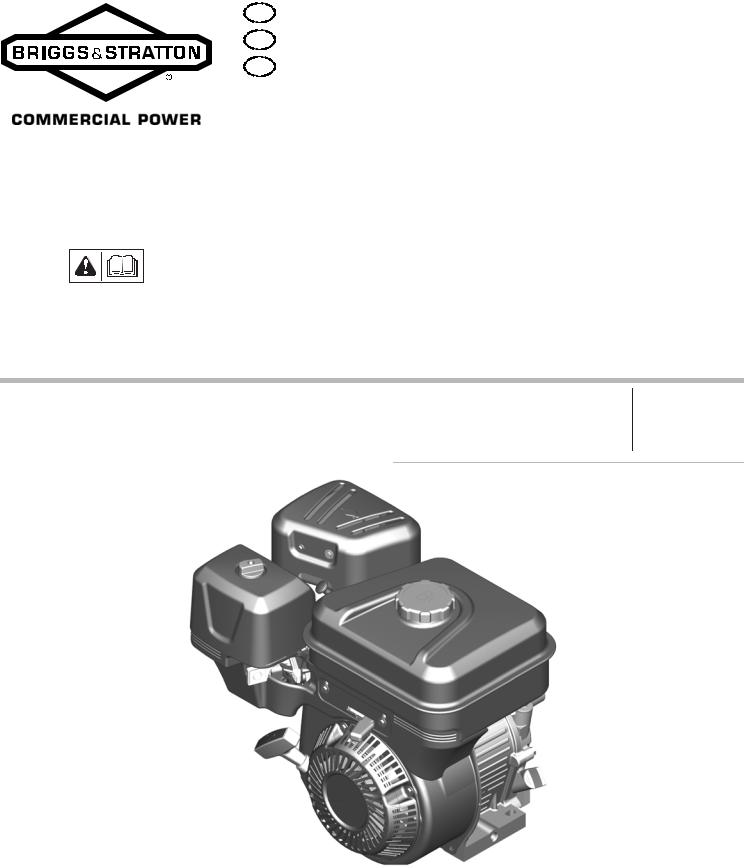
en
es
fr
Operator’s Manual Manual del Operario Manuel de l’opérateur
Reproduction |
||
|
for |
M del |
Not |
|
|
130000 Vanguardt
190000
Briggs & Stratton is a registered trademark of Briggs & Stratton Corporation
English
E 2011 Briggs & Stratton Corporation, |
Form No. 279770TRI |
|
Milwaukee, WI, USA. All rights reserved. |
Revision: C |
|
Español |
Français |
|
en |
|
es |
|
fr |
|
|
|
|
|
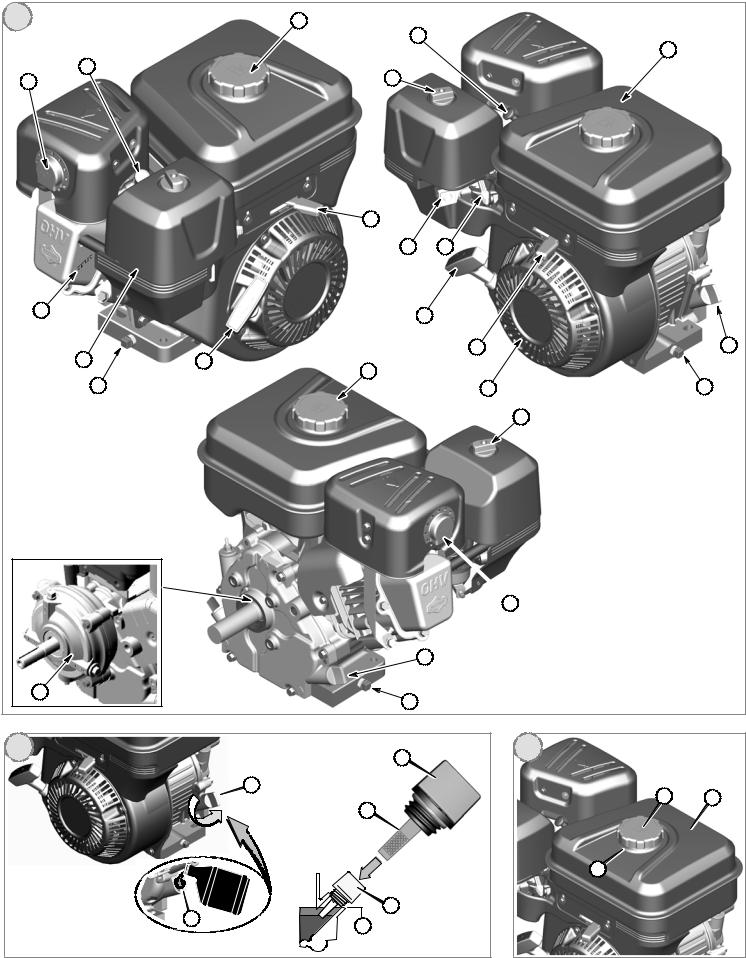
1 |
|
|
C |
|
B |
|
|
|
|
|
|
|
|
|
|
|
|
|
C |
|
B |
|
|
|
D |
|
|
H |
|
|
|
|
|
|
|
|
|
|
J |
|
|
|
|
|
|
K |
I |
|
A |
|
|
|
|
E |
|
|
|
|
|
|
|
|
D |
|
E |
|
|
J |
F |
|
|
C |
|
|
||
|
|
|
|
|
|
|
G |
|
|
|
for |
L |
G |
|
|
|
|
D |
|
|
|
|
|
Not |
|
|
|
|
|
|
|
|
|
|
|
|
|
|
|
H |
|
|
|
|
|
|
F |
|
M |
|
|
Reproduction |
|
||
|
|
|
|
G |
|
|
2 |
|
|
|
A |
3 |
|
|
|
|
|
|
|
|
|
|
|
A |
|
A |
B |
|
|
|
|
B |
||
|
|
|
|
|
|
|
|
|
|
|
|
C |
|
|
C |
|
|
A |
|
|
|
|
|
B |
|
|
|
|
|
|
|
|
|
|
2 |
|
|
|
|
VanguardEngines.com |
|
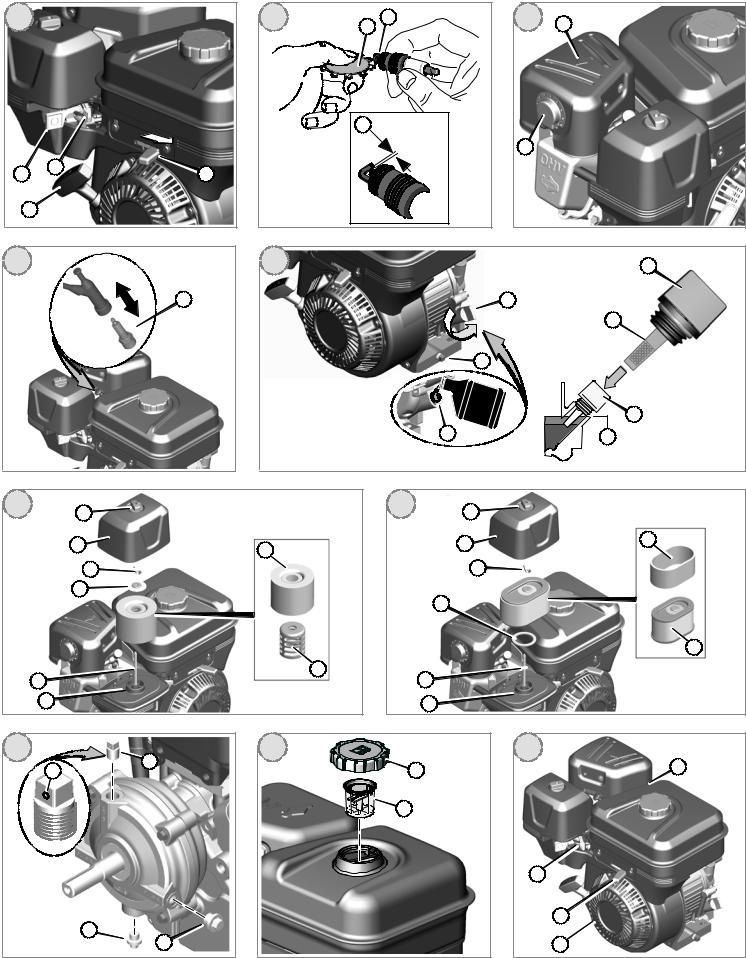
4 |
|
|
5 |
B |
A |
|
6 |
A |
|
|
|
|
|
|
|
||
|
|
|
|
A |
|
|
|
|
|
|
|
|
|
|
|
B |
|
A |
C |
|
B |
|
|
|
|
|
|
|
|
|
|
|
|
||
|
D |
|
|
|
|
|
|
|
7 |
|
|
8 |
|
|
|
|
D |
|
|
A |
|
|
|
|
D |
|
|
|
|
|
|
|
|
|
F |
|
|
|
|
|
|
B |
|
|
|
|
|
Reproduction |
|
||||
|
|
|
|
for |
|
|
D |
|
|
|
|
Not |
|
|
E |
|
E |
9 |
|
A |
|
|
10 |
A |
|
|
|
|
B |
E |
|
|
B |
|
D |
|
|
|
|
|
|
|
|
|
|
|
C |
|
|
|
C |
|
|
|
|
D |
|
|
|
|
|
|
|
|
|
|
|
|
F |
|
|
|
|
|
|
|
|
|
|
E |
|
H |
|
F |
|
|
H |
|
|
|
|
|
|
|
|
|
||
|
G |
|
|
|
|
G |
|
|
11 |
|
B |
12 |
|
|
|
13 |
|
|
D |
|
|
A |
|
|
C |
|
|
|
|
|
|
|
|||
|
|
|
|
|
B |
|
|
|
|
|
|
|
|
|
|
B |
|
|
|
A |
|
|
|
|
|
B |
|
|
|
|
|
|
|
|
|
|
|
C |
|
|
|
|
|
A |
3
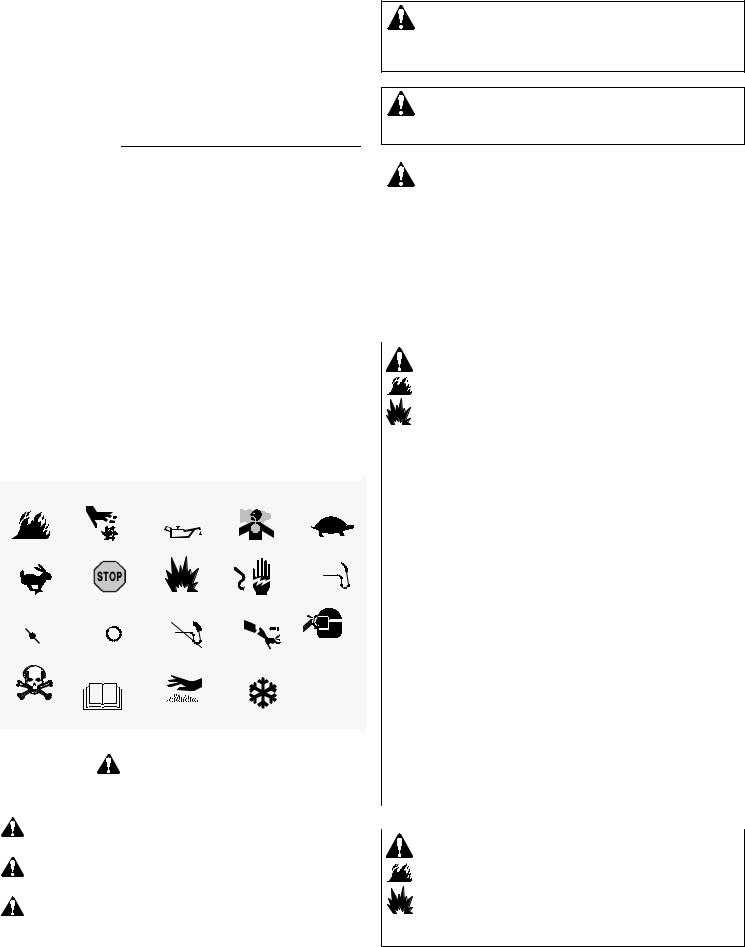
General Information
This manual contains safety information to make you aware of the hazards and risks associated with engines and how to avoid them. It also contains instructions for the proper use and care of the engine. Because Briggs & Stratton Corporation does not necessarily know what equipment this engine will power, it is important that you read and understand these instructions and the instructions for the equipment. Save these original instructions for future reference.
For replacement parts or technical assistance, record below the engine model, type, and code numbers along with the date of purchase. These numbers are located on your engine (see the Features and Controls page).
Date of purchase:
MM/DD/YYYY
|
Engine model: |
|
|
|
|
|
|
|
|
|
|
|
|
|
|
|
|
|
|
|
|
|
|
|
|
||||||
|
|
|
|
|
|
|
|
|
Model: |
Type: |
Code: |
|
|
|
|
|
WARNING |
||||||||||||||
|
|
|
|
|
|
|
|
|
|
|
|
|
|
|
|
|
|
|
|
|
|
|
|
|
|
|
|
|
Briggs & Stratton Engines are not designed for and are not to be used to power: |
||
|
|
|
|
|
|
|
|
|
|
|
|
|
|
|
|
|
|
|
|
|
|
|
|
|
|
|
|
|
fun-karts; go-karts; children’s, recreational, or sport all-terrain vehicles (ATVs); |
||
|
Power Rating |
|
|
|
|
|
|
|
|
|
|
|
|
|
|
|
|
|
|
|
|
|
motorbikes; hovercraft; aircraft products; or vehicles used in competitive events not |
||||||||
|
The gross power rating for individual gas engine models is labeled in accordance with |
|
sanctioned by Briggs & Stratton. For information about competitive racing products, |
||||||||||||||||||||||||||||
|
|
see www.briggsracing.com. For use with utility and side-by-side ATVs, please contact |
|||||||||||||||||||||||||||||
|
SAE (Society of Automotive Engineers) code J1940 (Small Engine Power & Torque |
|
|
|
|||||||||||||||||||||||||||
|
|
|
|
Briggs & Stratton Engine Application Center, 1-866-927-3349. Improper engine |
|||||||||||||||||||||||||||
|
Rating Procedure), and rating performance has been obtained and corrected in |
|
|
|
|||||||||||||||||||||||||||
|
|
|
|
application may result in serious injury or death. |
|||||||||||||||||||||||||||
|
accordance with SAE J1995 (Revision 2002--05). Torque values are derived at 3060 |
|
|
|
|||||||||||||||||||||||||||
|
|
|
|
|
|
|
|||||||||||||||||||||||||
|
|
|
|
|
|
|
|||||||||||||||||||||||||
|
RPM; horsepower values are derived at 3600 RPM. The gross power curves can be |
|
|
|
NOTICE: This engine was shipped from Briggs & Stratton without oil. Before you start |
||||||||||||||||||||||||||
|
viewed at www.BRIGGSandSTRATTON.COM. Net power values are taken with exhaust |
|
|||||||||||||||||||||||||||||
|
|
the engine, make sure you add oil according to the instructions in this manual. If you |
|||||||||||||||||||||||||||||
|
and air cleaner installed whereas gross power values are collected without these |
|
|
|
|||||||||||||||||||||||||||
|
|
|
|
start the engine without oil, it will be damaged beyond repair and will not be covered |
|||||||||||||||||||||||||||
|
attachments. Actual gross engine power will be higher than net engine power and is |
|
|
|
|||||||||||||||||||||||||||
|
|
|
|
under warranty. |
|||||||||||||||||||||||||||
|
affected by, among other things, ambient operating conditions and engine--to--engine |
|
|
|
|||||||||||||||||||||||||||
|
|
|
|
|
|
|
|||||||||||||||||||||||||
|
variability. Given the wide array of products on which engines are placed, the gas engine |
|
|
|
|
||||||||||||||||||||||||||
|
may not develop the rated gross power when used in a given piece of power equipment. |
|
|
|
|
||||||||||||||||||||||||||
|
|
|
|
|
|||||||||||||||||||||||||||
|
This difference is due to a variety of factors including, but not limited to, the variety of |
|
|
|
|
|
WARNING |
||||||||||||||||||||||||
|
engine components (air cleaner, exhaust, charging, cooling, carburetor, fuel pump, etc.), |
|
|
|
|||||||||||||||||||||||||||
|
application limitations, ambient operating conditions (temperature, humidity, altitude), and |
|
|
|
Fuel and its vapors are extremely flammable and explosive. |
||||||||||||||||||||||||||
|
engine--to--engine variability. |
|
|
|
|
|
|
|
|
|
|
|
|
|
|
|
|
|
|
|
|
|
|
|
|||||||
|
|
|
|
|
|
|
|
|
|
|
|
|
|
|
|
|
|
|
|
|
|
|
|
Fi e or expl si can cause severe burns or death. |
|||||||
|
Due to manufacturing and capacity limitations, Briggs & Stratton may substitute an |
|
|
|
|
|
|||||||||||||||||||||||||
|
|
|
|
|
|
|
|||||||||||||||||||||||||
|
engine of higher rated power for this Series engine. |
|
|
|
|
|
|
|
|
|
|
|
|
|
|
|
|||||||||||||||
|
Operator Safety |
|
|
|
|
|
|
|
|
|
|
|
|
When Adding Fuel |
|||||||||||||||||
|
|
|
|
|
|
|
|
|
|
|
|
|
Turn engine off and let engine cool at least 2 minutes before removing the fuel |
||||||||||||||||||
|
|
|
|
|
|
|
|
|
|
|
|
|
|
cap. |
|
||||||||||||||||
|
|
|
|
|
|
|
|
|
|
|
|
|
|
|
|
|
|
|
|
|
|
|
|
|
|
|
|
|
|
Fill f el tank outdoors or n well-ventilated area. |
|
|
|
|
|
|
|
|
|
|
|
|
|
|
|
|
|
|
|
|
|
|
|
|
|
|
|
for |
|
||||
|
|
|
|
SAFETY AND CONTROL SYMBOLS |
|
|
|
|
|
|
|
|
|
|
Do not overfill fuel tank. To allow for expansion of the fuel, do not fill above the |
||||||||||||||||
|
|
|
|
|
|
|
|
|
|
|
|
|
|
bottom of the fuel tank neck. |
|||||||||||||||||
|
|
|
|
|
|
|
|
|
|
|
|
|
|
|
|
|
|
|
|
|
|
|
|
|
|
|
|
|
|
Keep f el away from sparks, open flames, pilot lights, heat, and other ignition |
|
|
|
|
|
|
|
|
|
|
|
|
|
|
|
|
|
|
|
|
|
|
|
|
|
|
|
|
|
||||
|
|
|
|
|
|
|
|
|
|
|
|
|
|
|
|
|
|
|
|
|
|
|
|
|
|
|
|
|
|
sources. |
|
|
|
|
|
|
|
|
|
|
|
|
|
|
|
|
|
|
|
|
|
|
|
|
|
|
|
|
|
|
Check fuel lines, tank, cap, and fittings frequently for cracks or leaks. |
||
|
|
|
|
|
|
|
|
|
|
|
|
|
|
|
|
|
|
|
|
|
|
|
|
|
|
|
|
|
|
Replace if necessary |
|
|
|
Fire |
Moving Parts |
|
|
|
Oil |
Toxic Fumes |
|
Slow |
|
|
|
|
|||||||||||||||||
|
|
|
|
|
|
|
|
|
|
If fuel spills, wait until it evaporates before starting engine. |
|||||||||||||||||||||
|
|
|
|
|
|
|
|
|
|
|
|
|
|
|
|
|
|
Not |
|
|
|
|
|
|
|
||||||
|
|
|
|
|
|
|
|
|
|
|
|
|
|
|
|
|
|
|
|
|
|
|
|
When Starting Engine |
|||||||
|
|
|
|
|
|
|
|
|
|
|
|
|
|
|
|
|
|
|
|
|
|
|
|
|
|
|
|
|
|||
|
|
|
|
|
|
|
|
|
|
|
|
|
|
|
|
|
|
|
|
|
|
|
|
|
|
|
|
|
Ensure that spark plug, muffler, fuel cap and air cleaner (if equipped) are in |
||
|
|
|
|
|
|
|
|
|
|
|
|
|
|
|
|
|
|
|
|
|
|
|
|
|
|
|
|
||||
|
|
|
|
|
|
|
|
|
|
|
|
|
|
|
|
|
|
|
|
|
|
|
|
|
|
|
|
|
|
place and secured. |
|
|
|
Fast |
|
|
Stop |
|
|
Explosion |
|
Shock |
|
Fu l |
|
|
|
|
Do not crank engine with spark plug removed. |
||||||||||||||
|
|
|
|
|
|
|
|
|
|
|
|
|
|
|
|
|
|
|
|
|
|
|
|
|
|
|
|
|
If engine floods, set choke (if equipped) to OPEN/RUN position, move throttle |
||
|
|
|
|
|
|
|
|
|
|
|
|
|
|
|
|
|
|
|
|
|
|
|
|
|
|
|
|
|
|
(if equipped) to FAST position and crank until engine starts. |
|
|
|
|
|
|
|
|
|
|
|
|
|
|
|
|
|
|
|
|
|
Wear Eye |
|
|
|
When Operating Equipment |
|||||||
|
|
|
|
|
|
|
|
|
|
|
|
|
|
|
|
|
|
|
|
|
|
||||||||||
|
Choke |
|
On Off |
|
|
Fuel Shutoff |
|
Kickback |
|
|
|
|
Do not tip engine or equipment at angle which causes fuel to spill. |
||||||||||||||||||
|
|
|
|
|
Protection |
|
|||||||||||||||||||||||||
|
|
|
|
|
|
Do not choke the carburetor to stop engine. |
|||||||||||||||||||||||||
|
|
|
|
|
|
|
|
|
|
|
|
|
|
|
|
|
|
|
|
|
|
|
|
|
|
|
|
|
|||
|
|
|
|
|
|
|
|
|
|
|
|
|
|
|
|
|
|
|
|
|
|
|
|
|
|
|
|
|
Never start or run the engine with the air cleaner assembly (if equipped) or the |
||
|
|
|
|
|
|
|
|
|
|
|
|
|
|
|
|
|
|
|
|
|
|
|
|
|
|
|
|
|
|
air filter (if equipped) removed. |
|
|
|
|
|
|
|
|
|
|
|
|
|
|
|
|
|
|
|
Reproduction |
|||||||||||||
|
Hazardous |
|
|
|
|
|
|
|
|
|
|
|
|
|
|
|
|
|
|
|
|
|
|
|
|
|
When Changing Oil |
||||
|
|
|
|
|
|
|
|
|
|
|
|
|
|
|
|
|
|
|
|
|
|
|
|
|
|||||||
|
Chemical |
Read Manual |
Hot Surface |
|
Frostbite |
|
|
|
|
|
|
|
|
|
|
When you drain the oil from the top oil fill tube, the fuel tank must be empty or |
|||||||||||||||
|
|
|
|
|
|
|
|
|
|
|
|
|
|
|
|
|
|
|
|
|
|
|
|
|
|
|
|
|
|
fuel can leak out and result in a fire or explosion. |
|
|
|
|
|
|
|
|
|
|
|
|
|
|
|
|
|
|
|
|
|
|
|
|
|
|
|
|
|
|
|
||
|
|
|
|
|
|
|
|
|
|
|
|
|
|
|
|
|
|
|
|
|
|
|
|
|
|
|
|
|
When Transporting Equipment |
||
|
|
|
|
|
|
|
|
|
|
|
|
|
|
|
|
|
|
|
|
|
|
|
|
|
|
|
|
|
Transport with fuel tank EMPTY or with fuel shut-off valve OFF. |
||
|
The safety alert symbol |
is used to identify safety information about hazards that can |
|
When Storing Fuel Or Equipment With Fuel In Tank |
|||||||||||||||||||||||||||
|
result in personal injury. A signal word (DANGER, WARNING, or CAUTION) is used with the |
|
|
Store away from furnaces, stoves, water heaters or other appliances that have |
|||||||||||||||||||||||||||
|
alert symbol to indicate the likelihood and the potential severity of injury. In addition, a hazard |
|
|
pilot lights or other ignition sources because they can ignite fuel vapors. |
|||||||||||||||||||||||||||
|
symbol may be used to represent the type of hazard. |
|
|
|
|
|
|
|
|
|
|
|
|
|
|
|
|||||||||||||||
|
|
|
|
|
|
|
|
|
|
|
|
|
|
|
|
||||||||||||||||
|
|
DANGER indicates a hazard which, if not avoided, will result in death or |
|
|
|
|
|
|
|||||||||||||||||||||||
|
|
|
|
|
|
|
|
||||||||||||||||||||||||
|
|
serious injury. |
|
|
|
|
|
|
|
|
|
|
|
|
|
|
|
|
|
|
|
|
|
|
|
WARNING |
|||||
|
|
|
|
|
|
|
|
|
|
|
|
|
|
|
|
|
|
|
|
|
|
|
|
|
|
|
|
|
|
|
|
|
|
WARNING indicates a hazard which, if not avoided, could result in death or |
|
|
|
Starting engine creates sparking. |
|||||||||||||||||||||||||
|
|
serious injury. |
|
|
|
|
|
|
|
|
|
|
|
|
|
|
|
|
|
|
|
|
|
|
|
Sparking can ignite nearby flammable gases. |
|||||
|
|
|
|
|
|
|
|
|
|
|
|
|
|
|
|
|
|
|
|
|
|
|
|
|
|
|
|
|
|
|
Explosion and fire could result. |
|
|
CAUTION indicates a hazard which, if not avoided, could result in minor or |
|
|
If there is natural or LP gas leakage in area, do not start engine. |
||||||||||||||||||||||||||
|
|
moderate injury. |
|
|
|
|
|
|
|
|
|
|
|
|
|
|
|
|
|
|
|
|
|
|
|||||||
|
|
|
|
|
|
|
|
|
|
|
|
|
|
|
|
|
|
|
|
|
|
|
|
|
|
|
|
|
Do not use pressurized starting fluids because vapors are flammable. |
||
NOTICE indicates a situation that could result in damage to the product.
4 |
VanguardEngines.com |
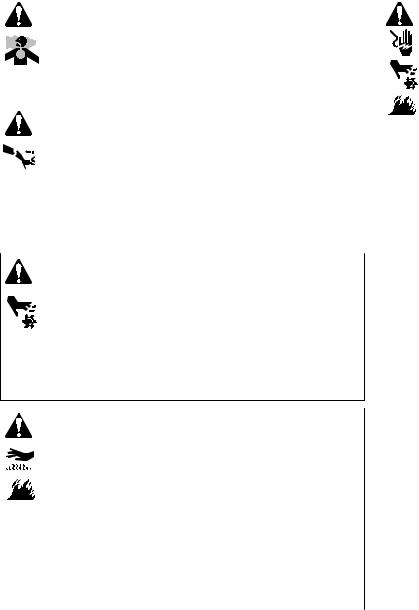
|
|
WARNING |
|
WARNING |
|
|
Engines give off carbon monoxide, an odorless, colorless, poison gas. |
|
Unintentional sparking can result in fire or electric shock. |
|
|
|||
|
|
Breathing carbon monoxide can cause nausea, fainting or death. |
|
Unintentional start-up can result in entanglement, traumatic |
|
|
|
|
amputation, or laceration. |
|
Start and run engine outdoors. |
|
Fire hazard |
|
|
Do not start or run engine in enclosed area, even if doors or windows are open. |
|
|
|
|
|
|
|
|
|
|
|
|
|
|
|
WARNING |
|
Before performing adjustments or repairs: |
|
|
Rapid retraction of starter cord (kickback) will pull hand and arm |
|
Disconnect the spark plug wire and keep it away from the spark plug. |
|
|
toward engine faster than you can let go. |
|
Disconnect battery at negative terminal (only engines with electric start.) |
|
|
Broken bones, fractures, bruises or sprains could result. |
|
Use only correct tools. |
|
When starting engine, pull the starter cord slowly until resistance is felt and then |
|
Do not tamper with governor spring, links or other parts to increase engine |
|
|
|
speed. |
||
|
pull rapidly to avoid kickback. |
|
||
|
|
Replacement parts must be of the same design and installed in the same |
||
|
Remove all external equipment/engine loads before starting engine. |
|
||
|
|
position as the original parts. Other parts may not perform as well, may damage |
||
|
Direct-coupled equipment components such as, but not limited to, blades, |
|
||
|
|
the unit, and may result in injury. |
||
|
impellers, pulleys, sprockets, etc., must be securely attached. |
|
||
|
|
Do not strike the flywheel with a hammer or hard object because the flywheel |
||
|
|
|
|
|
|
|
|
|
may later shatter during operation. |
|
|
|
||
|
|
|
|
When testing for spark: |
|
|
WARNING |
|
Use approved spark plug tester. |
|
|
Rotating parts can contact or entangle hands, feet, hair, clothing, or |
|
Do not check for spark with spark plug removed. |
|
|
|
|
|
|
|
accessories. |
|
|
|
|
Traumatic amputation or severe laceration can result. |
|
|
Operate equipment with guards in place.
Keep hands and feet away from rotating parts.
Tie up long hair and remove jewelry.
Do not wear loose-fitting clothing, dangling drawstrings or items that could become caught.
|
|
WARNING |
|
for |
|
|
Running engines produce heat. Engine parts, especially muffler, |
||
|
|
become extremely hot. |
|
|
|
|
Severe thermal burns can occur on contact. |
|
|
|
|
|
||
|
|
|
|
|
|
|
Combustible debris, such as leaves, grass, brush, etc. can catch fire. |
|
|
|
Allow muffler, engine cylinder and fins to cool before touching. |
|
||
|
Remove accumulated debris from muffler area and cylinder area. |
|
||
|
It is a violation of California Public Resource Code, Section 4442, to use or |
|
||
|
operate the engine on any forest-covered, brush-covered, or grass-cove ed land |
|
||
|
unless the exhaust system is equipped with a spark arrester,Notas defined in |
|
||
|
Section 4442, maintained in effective working order. Other states or fede al |
|
||
|
jurisdictions may have similar laws. Contact the original equipment |
|
||
|
manufacturer, retailer, or dealer to obtain a spark arrester sign d for the |
|
||
|
exhaust system installed on this engine. |
Reproduction |
||
|
|
|
||
|
5 |
|
en |
||
|
||
|
|
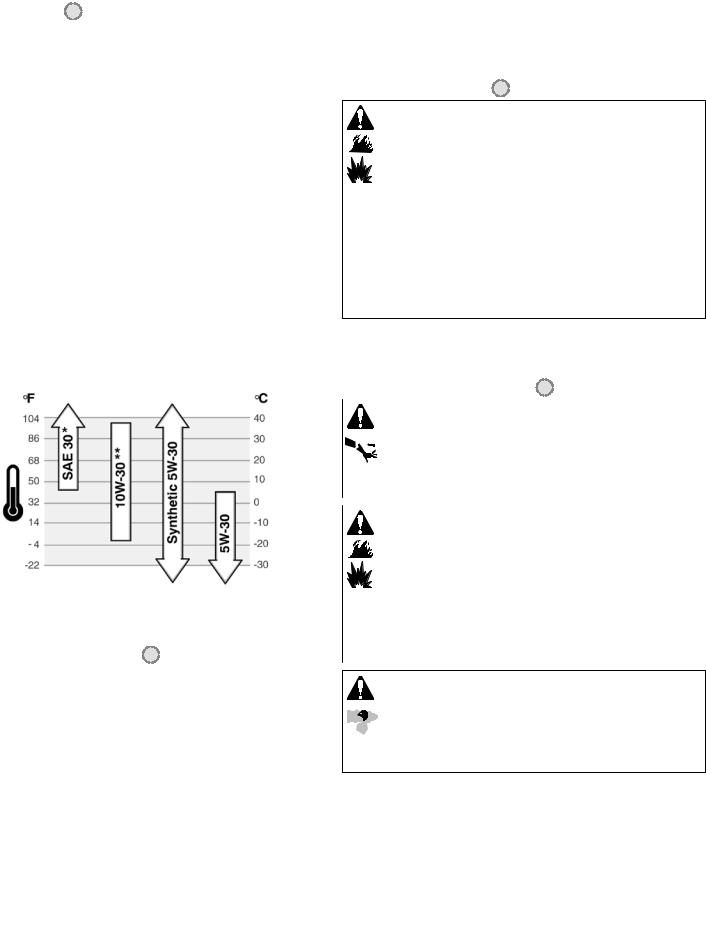
Features and Controls
Compare the illustration 1 with your engine to familiarize yourself with the location of various features and controls.
A.Engine Identification
Model Type Code
B.Spark Plug
C.Fuel Tank and Cap
D.Air Cleaner
E.Starter Cord Handle
F.Oil Fill and Dipstick
G.Oil Drain Plug
H.Muffler
Muffler Guard (optional) Spark Arrester (optional)
I.Choke Control
J.Throttle Control (optional)
K.TransportGuardt -- Fuel/Ignition Lever
L.Finger Guard
M.Gear Reduction Unit (optional)
Operation
Oil capacity (see the Specifications section)
Oil Recommendations
High Altitude
At altitudes over 5,000 feet (1524 meters), a minimum 85 octane/85 AKI (89 RON) gasoline is acceptable. To remain emissions compliant, high altitude adjustment is required. Operation without this adjustment will cause decreased performance, increased fuel consumption, and increased emissions. See a Briggs & Stratton Authorized Dealer for high altitude adjustment information.
Operation of the engine at altitudes below 2,500 feet (762 meters) with the high altitude kit is not recommended.
How To Add Fuel - Figure 3
WARNING
Fuel and its vapors are extremely flammable and explosive.
Fire or explosion can cause severe burns or death.
When Adding Fuel
Turn engine off and let engine cool at least 2 minutes before removing the fuel cap.
Fill fuel tank outdoors or in well-ventilated area.
Do not overfill fuel tank. To allow for expansion of the fuel, do not fill above the bottom of the fuel tank neck.
Keep fuel away from sparks, open flames, pilot lights, heat, and other ignition sources.
Check fuel lines, tank, cap, and fittings frequently for cracks or leaks. Replace if necessary
If fuel spills, wait until it evaporates before starting engine.
We recommend the use of Briggs & Stratton Warranty Certified oils for best |
|
|
1. Clean the fuel cap area of dirt and debris. Remove the fuel cap (A, Figure 3). |
||
performance. Other high-quality detergent oils are acceptable if classified for service SF, |
2. Fill the fuel tank (B) with fuel. To allow for expansion of the fuel, do not fill above the |
||||
SG, SH, SJ or higher. Do not use special additives. |
|
|
|
bottom of the fuel tank eck (C). |
|
Outdoor temperatures determine the proper oil viscosity for the engine. Use the chart to |
3. Reinstall the fuel cap. |
||||
select the best viscosity for the outdoor temperature range expected. |
|
|
H w To Start The Eng ne - Figure 4 |
||
|
|
|
|
|
|
|
|
|
|
|
|
|
|
|
|
|
|
|
|
|
|
|
WARNING |
|
|
|
|
|
Rapid re ra ion of starter cord (kickback) will pull hand and arm |
|
|
Not |
|
for toward engine faster than you can let go. |
|
|
|
|
|
Broken bones, fractures, bruises or sprains could result. |
|
|
|
|
|
When starting engine, pull the starter cord slowly until resistance is felt and then |
|
|
|
|
|
ll rapidly to avoid kickback. |
|
|
|
|
|
|
|
|
|
|
|
|
|
|
|
|
|
WARNING |
|
|
|
|
|
Fuel and its vapors are extremely flammable and explosive. |
|
|
|
|
|
|
|
|
|
|
|
|
Fire or explosion can cause severe burns or death. |
|
|
|
|
|
When Starting Engine |
* Below 40°F (4°C) the use of SAE 30 will result in hard starting. |
|
|
|||
|
|
Ensure that spark plug, muffler, fuel cap and air cleaner (if equipped) are in |
|||
** Above 80°F (27°C) the use of 10W-30 may cause increased oil consumption. Check |
place and secured. |
||||
oil level more frequently. |
|
|
|
|
Do not crank engine with spark plug removed. |
|
2 |
|
|
|
If engine floods, set choke (if equipped) to OPEN/RUN position, move throttle |
How To Check/Add Oil - Figure |
|
|
|
(if equipped) to FAST position and crank until engine starts. |
|
|
|
Reproduction |
|||
1.Remove the dipstick (A) and wipe with a clean cloth.
2.Insert the dipstick. Do not turn or tighten.
3.Remove the dipstick and check the oil level. It should be at the top of the full indicator (B) on the dipstick.
4.To add oil, pour the oil slowly into the engine oil fill (C). Fill to point of overflowing.
5.Replace and tighten the dipstick.
Fuel Recommendations
Fuel must meet these requirements:
Clean, fresh, unleaded gasoline.
A minimum of 87 octane/87 AKI (91 RON). High altitude use, see below.
Gasoline with up to 10% ethanol (gasohol) is acceptable.
CAUTION: Do not use unapproved gasolines, such as E15 and E85. Do not mix oil in gasoline or modify the engine to run on alternate fuels. This will damage the engine components and void the engine warranty.
To protect the fuel system from gum formation, mix a fuel stabilizer into the fuel. See Storage. All fuel is not the same. If starting or performance problems occur, change fuel providers or change brands. This engine is certified to operate on gasoline. The emissions control system for this engine is EM (Engine Modifications).
WARNING
Engines give off carbon monoxide, an odorless, colorless, poison gas.  Breathing carbon monoxide can cause nausea, fainting or death.
Breathing carbon monoxide can cause nausea, fainting or death.
Start and run engine outdoors.
Do not start or run engine in enclosed area, even if doors or windows are open.
NOTICE: This engine was shipped from Briggs & Stratton without oil. Before you start the engine, make sure you add oil according to the instructions in this manual. If you start the engine without oil, it will be damaged beyond repair and will not be covered under warranty.
Note: Some engines and equipment have remote controls. See the equipment manual for location and operation of remote controls.
1.Check the oil level. See the How To Check/Add Oil section.
2.Make sure equipment drive controls, if equipped, are disengaged.
3.Move the fuel/ignition lever (A) to the on  position (Figure 4).
position (Figure 4).
4.Move the throttle control (B), if equipped, to the fast  position. Operate the engine in the fast
position. Operate the engine in the fast  position.
position.
6 |
VanguardEngines.com |
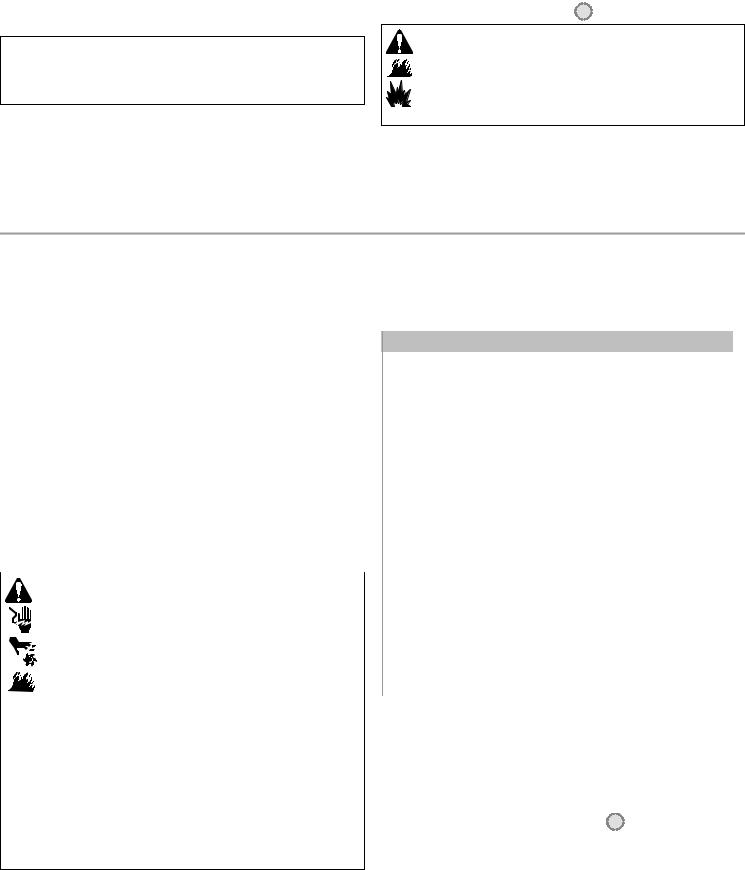
5.Move the choke control (C) to the choke 

 position.
position.
Note: Choke is usually unnecessary when restarting a warm engine.
6.Rewind Start: Firmly hold the starter cord handle (D). Pull the starter cord handle slowly until resistance is felt, then pull rapidly (Figure 4).
Note: If the engine does not start after repeated attempts, go to
VanguardEngines.com or call 1-800-999-9333 (in USA).
 WARNING: Rapid retraction of the starter cord (kickback) will pull your
WARNING: Rapid retraction of the starter cord (kickback) will pull your
hand and arm toward the engine faster than you can let go. Broken bones, fractures, bruises or sprains could result. When starting engine, pull the starter cord slowly until resistance is felt and then pull rapidly to avoid kickback.
7.Electric Start: Turn the electric start switch to the on/start position.
Note: If the engine does not start after repeated attempts, go to
VanguardEngines.com or call 1-800-999-9333 (in USA).
NOTICE: To extend the life of the starter, use short starting cycles (five seconds maximum). Wait one minute between starting cycles.
8.As the engine warms up, move the choke control (C) to the run 

 position (Figure 4).
position (Figure 4).
How To Stop The Engine - Figure 4
WARNING
Fuel and its vapors are extremely flammable and explosive. Fire or explosion can cause severe burns or death.
Do not choke the carburetor to stop engine.
Move the fuel/ignition lever (A) to the off  position.
position.
amputation, or laceration. |
Reproduction |
|||||
Maintenance |
|
for |
|
|||
|
|
|
|
Maintenance Chart |
|
|
We recommend that you see any Briggs & Stratton Authorized Dealer for all |
|
|
Fi st 5 Hours |
|
||
maintenance and service of the engine and engine parts. |
|
|
|
|
Change oil |
|
NOTICE: All the components used to build this engine must remain in place for proper |
Every 8 Hours or Da ly |
|
||||
operation. |
|
|
|
|
|
|
|
|
|
|
|
Che k engine oil level |
|
|
|
|
|
Clean area around muffler and controls |
|
|
|
|
|
|
|
Clean finger guard |
|
Emissions Control |
|
|
|
Every 25 Ho rs or Annually |
|
|
Maintenance, replacement, or repair of the emissions control devices and systems |
|
|
|
|||
may be performed by any non-road engine repair establishment or individual. |
|
|
Clean air filter * |
|
||
However, to obtain “no charge” emissions control service, the work must be pe fo med |
|
Clean pre-cleaner * |
|
|||
by a factory authorized dealer. See the Emissions Warranty. |
Not |
|
|
|
|
|
|
|
Every 50 Hours or Annually |
|
|||
|
|
|
|
|||
|
|
|
|
|
Change engine oil |
|
|
|
|
|
Check muffler and spark arrester |
|
|
|
|
|
|
|
|
|
|
|
|
|
Every 100 Hours |
|
|
|
|
|
|
|
|
|
|
|
|
|
Change gear reduction oil (if equipped) |
|
|
|
|
|
|
|
||
WARNING |
|
|
|
|
|
|
|
|
|
Annually |
|
||
Unintentional sparking can result in fire or electric shock. |
|
|
|
|
|
|
|
|
|
Replace air filter |
|
||
Unintentional start-up can result in entanglement, traumatic |
|
|
|
|||
|
|
Replace pre-cleaner |
|
|||
|
|
|
|
|
||
Fire hazard |
|
|
|
|
Replace spark plug |
|
|
|
|
|
|
Clean/Replace debris strainer |
|
|
|
|
|
Clean air cooling system * |
|
|
|
|
|
|
Check valve clearance. Adjust if necessary. |
|
|
Before performing adjustments or repairs: |
|
|
|
|
|
|
|
|
|
* In dusty conditions or when airborne debris is present, clean more often. |
|||
Disconnect the spark plug wire and keep it away from the spark plug. |
|
|
||||
|
|
|
|
|
||
Disconnect battery at negative terminal (only engines with electric start.) |
|
|
|
|
|
|
Use only correct tools. |
|
|
|
Carburetor Adjustment |
||
Do not tamper with governor spring, links or other parts to increase engine |
|
|
Never make adjustments to the carburetor. The carburetor was set at the factory to |
|||
speed. |
|
|
|
operate efficiently under most conditions. However, if adjustments are required, see any |
||
Replacement parts must be of the same design and installed in the same |
|
|
Briggs & Stratton Authorized Dealer for service. |
|||
position as the original parts. Other parts may not perform as well, may damage |
|
|
NOTICE: The manufacturer of the equipment on which this engine is installed specifies |
|||
the unit, and may result in injury. |
|
|
|
the top speed at which the engine will be operated. Do not exceed this speed. |
||
Do not strike the flywheel with a hammer or hard object because the flywheel
may later shatter during operation. |
How To Check The Spark Plug - Figure 5 |
|
When testing for spark: |
||
Check the gap (A, Figure 5) with a wire gauge (B). If necessary, reset the gap. Install |
||
Use approved spark plug tester. |
||
and tighten the spark plug to the recommended torque. For gap setting or torque, see the |
||
Do not check for spark with spark plug removed. |
Specifications section. |
|
|
Note: In some areas, local law requires using a resistor spark plug to suppress ignition |
|
|
signals. If this engine was originally equipped with a resistor spark plug, use the same |
|
|
type for replacement. |
|
7 |
|
en |
||
|
||
|
|
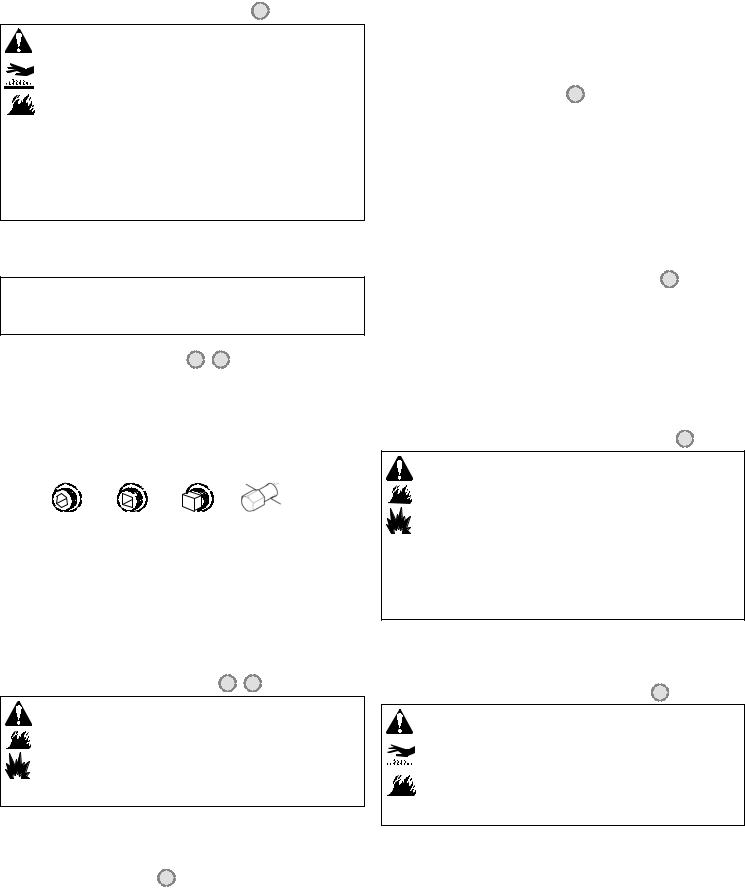
Inspect Muffler And Spark Arrester - Figure 6
WARNING
Running engines produce heat. Engine parts, especially muffler, become extremely hot.
Severe thermal burns can occur on contact.
Combustible debris, such as leaves, grass, brush, etc. can catch fire.
Allow muffler, engine cylinder and fins to cool before touching.
Remove accumulated debris from muffler area and cylinder area.
It is a violation of California Public Resource Code, Section 4442, to use or operate the engine on any forest-covered, brush-covered, or grass-covered land unless the exhaust system is equipped with a spark arrester, as defined in Section 4442, maintained in effective working order. Other states or federal jurisdictions may have similar laws. Contact the original equipment manufacturer, retailer, or dealer to obtain a spark arrester designed for the exhaust system installed on this engine.
Remove accumulated debris from muffler area and cylinder area. Inspect the muffler (A, Figure 6) for cracks, corrosion, or other damage. Remove the spark arrester (B), if equipped, and inspect for damage or carbon blockage. If damage is found, install replacement parts before operating.
 WARNING: Replacement parts must be of the same design and installed
WARNING: Replacement parts must be of the same design and installed
in the same position as the original parts. Other parts may not perform as well, may damage the unit, and may result in injury.
5.Saturate the foam element with clean engine oil. To remove the excess engine oil, squeeze the foam element in a clean cloth.
6.Insert the support cup into the foam element.
7.Install the foam element into the base (G) and onto stud (H). Make sure foam element is properly assembled into base and secure with the washer and the fastener.
8.Install the air filter cover and secure with the fastener. Make sure the fastener is tight.
High Capacity Air Filter - Figure 10
The air cleaner system uses a pleated filter with an optional pre-cleaner. The pre-cleaner can be washed and reused.
1.Loosen the fastener (A) that holds the cover (B). Remove the cover.
2.Remove the fastener (C), the pre-cleaner (D), if equipped, and the filter (E).
3.Remove the pre-cleaner, if equipped, from the filter. To loosen debris, gently tap the filter on a hard surface. If the filter is excessively dirty, replace with a new filter.
4.Wash the pre-cleaner in liquid detergent and water. Then allow it to thoroughly air dry. Do not oil the pre-cleaner.
5.Assemble the dry pre-cleaner to the filter.
6.Install the seal washer (F), the filter, and the pre-cleaner, if equipped, into the base (G) and onto stud (H). Make sure filter is properly assembled into base and secure with the fastener.
7.Install the air filter cover and secure with the fastener. Make sure the fastener is tight.
How To Change The Gear Reduction Oil - Figure 11
If your engine is equipped with a gear reduction unit, service as follows.
1.Remove the oil fill plug (B) and the oil level plug (C).
2.Remove the oil drain plug (A, Figure 11) and drain the oil into an appropriate receptacle.
|
|
|
|
|
3. Install and tighten the oil drain plug. |
|||
How To Change The Oil - Figure 7 |
8 |
|
|
4. To refill, slowly pour gear lube into the oil fill hole (see Specifications section). |
||||
|
|
|
Continue to pour until the oil ru s out of the oil level hole. |
|||||
Used oil is a hazardous waste product and must be disposed of properly. Do not discard |
|
|||||||
5. Install and tighten the oil level plug. |
||||||||
with household waste. Check with your local authorities, service center, or dealer for safe |
||||||||
6. |
Install and tighten the il fill plug. |
|||||||
disposal/recycling facilities. |
|
|
|
|||||
|
|
|
|
Imp tant: The l f ll plug has a ve hole (D) and must be installed on the top of the |
||||
|
|
|
|
|
|
|||
Remove Oil |
|
|
|
|
gear case cover as sh wn. |
|||
1. |
With engine off but still warm, disconnect the spark plug wire (A) and keep it away |
H |
w To Clean/Replace The Debris Strainer - Figure 12 |
|||||
|
from the spark plug (Figure 7). |
|
|
|
||||
|
|
|
for |
|
||||
2. |
Remove the oil drain plug (B, Figure 8). Drain the oil into an approved recep acle. |
|
||||||
|
Note: Any of the oil drain plugs shown below may be installed in the engine. |
WARNING |
||||||
|
|
|
|
|||||
|
|
|
|
|
|
|
||
|
|
|
|
|
|
|
F el and its vapors are extremely flammable and explosive. |
|
|
|
|
|
|
|
|
Fire or explosion can cause severe burns or death. |
|
3. |
After the oil has drained, install and tighten the oil drain plug. |
|
|
|
|
|||
Add oil |
|
Not |
|
|
Keep fuel away from sparks, open flames, pilot lights, heat, and other ignition |
|||
|
Place engine level. |
|
|
|
sources. |
|||
|
|
|
Check fuel lines, tank, cap, and fittings frequently for cracks or leaks. |
|||||
|
Clean the oil fill area of any debris. |
|
|
|
||||
|
|
|
|
Replace if necessary. |
||||
|
See the Specifications section for oil capacity. |
|
|
|
|
|||
|
|
|
|
Replacement parts must be the same and installed in the same position as the |
||||
1. |
Remove the dipstick (D) and wipe with a clean cloth. |
|
|
|||||
|
|
|
original parts. |
|||||
2. |
Pour the oil slowly into the engine oil fill (E). Fill to point of ov rflowing. |
|
|
|||||
|
|
If fuel spills, wait until it evaporates before starting engine. |
||||||
3. |
Insert the dipstick. Do not turn or tighten. |
|
|
|
||||
|
|
|
|
|
|
|||
4. |
Remove the dipstick and check the oil level. It should be at the top of the full indicator 1. |
Remove the fuel cap (A, Figure 12). |
||||||
|
(F) on the dipstick. |
|
|
|
2. |
Remove the debris strainer (B). |
||
|
|
|
Rep10 roduction |
|||||
3. If the debris strainer is dirty, clean or replace it. If you replace the debris strainer, make sure to use an original equipment replacement debris strainer.
How To Clean The Air Cooling System - Figure 13
Two types of air filter systems are shown, a Standard and a High Capacity. Determine the type installed on your engine and service as follows.
Standard Air Filter - Figure 9
The standard air filter uses a foam element that can be washed and reused.
1.Loosen the fastener (A) that holds the cover (B). Remove the cover.
2.Remove the fastener (C), the washer (D), and the foam element (E).
3.Remove the support cup (F) from the foam element.
4.Wash the foam element in liquid detergent and water. Squeeze dry the foam element in a clean cloth.
WARNING
Running engines produce heat. Engine parts, especially muffler, become extremely hot.
Severe thermal burns can occur on contact.
Combustible debris, such as leaves, grass, brush, etc. can catch fire.
Allow muffler, engine cylinder and fins to cool before touching.
Remove accumulated debris from muffler area and cylinder area.
NOTICE: Do not use water to clean the engine. Water could contaminate the fuel system. Use a brush or dry cloth to clean the engine.
This is an air cooled engine. Dirt or debris can restrict air flow and cause the engine to overheat, resulting in poor performance and reduced engine life.
Use a brush or dry cloth to remove debris from the finger guard (A). Keep linkage, springs and controls (B) clean. Keep the area around and behind the muffler (C) free of any combustible debris (Figure 13).
After a period of time, debris can accumulate in the cylinder cooling fins and cause the engine to overheat. This debris cannot be removed without partial disassembly of the engine. Have a Briggs & Stratton Authorized Dealer inspect and clean the air cooling system as recommended in the Maintenance Chart.
8 |
VanguardEngines.com |
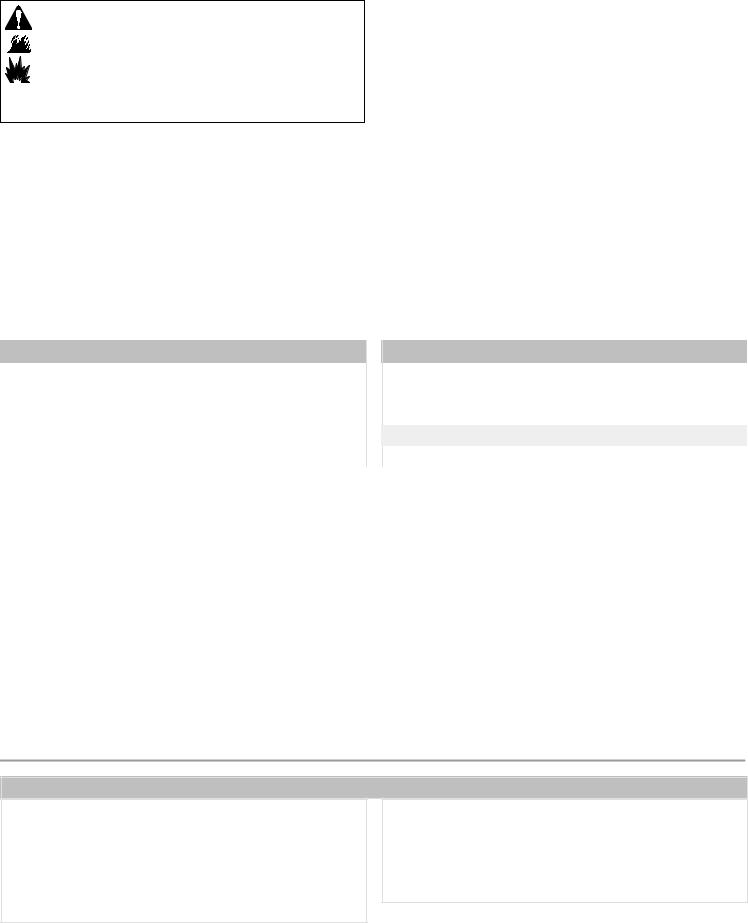
Storage
WARNING
Fuel and its vapors are extremely flammable and explosive. Fire or explosion can cause severe burns or death.
When Storing Fuel Or Equipment With Fuel In Tank
Store away from furnaces, stoves, water heaters or other appliances that have pilot light or other ignition source because they can ignite fuel vapors.
Fuel System
Fuel can become stale when stored over 30 days. Stale fuel causes acid and gum
deposits to form in the fuel system or on essential carburetor parts. To keep fuel fresh, use Briggs & Stratton FRESH START® fuel stabilizer, available as a liquid additive or a drip concentrate cartridge.
There is no need to drain gasoline from the engine if a fuel stabilizer is added according to instructions. Run the engine for 2 minutes to circulate the stabilizer throughout the fuel system. The engine and fuel can then be stored up to 24 months.
If gasoline in the engine has not been treated with a fuel stabilizer, it must be drained into an approved container. Run the engine until it stops from lack of fuel. The use of a fuel stabilizer in the storage container is recommended to maintain freshness.
Engine Oil
While the engine is still warm, change the engine oil.
Troubleshooting
Need Assistance? Go to VanguardEngines.com or call 1-800-999-9333.
Specifications
|
|
|
|
|
|
|
|
|
|
Reproduction |
|
||||
Engine Specifications |
|
|
|
|
Engine Specifications |
|
|
Model |
130000 |
|
|
|
Model |
|
190000 |
|
|
|
|
|
|||
Displacement |
12.48 ci (205 cc) |
|
Displacement |
18.63 ci (305 cc) |
|||
|
|
|
|
|
|
||
Bore |
2.688 in (68.28 mm) |
|
B re |
|
3.120 in (79.24 mm) |
||
|
|
|
|
|
|
|
|
|
|
|
Not |
|
|
|
|
Stroke |
2.200 in (55.88 mm) |
|
Stroke |
|
2.438 in (61.93 mm) |
||
|
|
for |
|
||||
Engine Oil Capacity |
20 -- 22 oz (0.59 -- 0.65 L) |
Engine Oil Capa ity |
26 -- 28 oz (0.77 -- 0.83 L) |
||||
Gear Reduction Specifications |
|
|
|
|
Gear |
ction Specifications |
|
Gear Reduction Oil Type |
80W-90 |
|
|
|
Gear |
Oil Type |
SAE 30 |
|
|
|
|
|
|
||
Gear Reduction Oil Capacity |
4 oz (0.12 L) |
|
|
Gear Reduction Oil Capacity |
12 oz (0.35 L) |
||
|
|
|
|
|
|
|
|
|
|
|
|
|
|
|
|
Tune-up Specifications * |
|
|
|
|
Tune-up Specifications * |
|
|
Model |
130000 |
|
|
|
Model |
|
190000 |
|
|
|
|
|
|||
Spark Plug Gap |
0.030 in (0.76 mm) |
|
Spark Plug Gap |
0.030 in (0.76 mm) |
|||
|
|
|
|
|
|||
Spark Plug Torque |
180 lb-in (20 Nm) |
|
Spark Plug Torque |
180 lb-in (20 Nm) |
|||
|
|
|
|
|
|||
Armature Air Gap |
0.010 - 0.014 in (0.25 - 0.36 mm) |
|
Armature Air Gap |
0.010 - 0.014 in (0.25 - 0.36 mm) |
|||
|
|
|
|
|
|||
Intake Valve Clearance |
0.004 - 0.006 in (0.10 - 0.15 mm) |
|
Intake Valve Clearance |
0.004 - 0.006 in (0.10 - 0.15 mm) |
|||
|
|
|
|
|
|||
Exhaust Valve Clearance |
0.009 - 0.011 in (0.23 - 0.28 mm) |
|
Exhaust Valve Clearance |
0.004 - 0.006 in (0.10 - 0.15 mm) |
|||
|
|
|
|
|
|
|
|
* Engine power will decrease 3.5% for each 1,000 feet (300 meters) above sea level and 1% for each 10 F (5.6 C) above 77 F (25 C). The engine will operate satisfactorily at an angle up to 15 . Refer to the equipment operator’s manual for safe allowable operating limits on slopes.
Common Service Parts n
Service Part |
Part Number |
|
|
High Capacity Air Filter, Model 130000 |
797033 |
|
|
High Capacity Air Filter Pre-cleaner, Model 130000 |
798513 |
|
|
High Capacity Air Filter, Model 190000 |
797032 |
|
|
High Capacity Air Filter Pre-cleaner, Model 190000 |
798795 |
|
|
Standard Air Filter, Model 130000 |
797378 |
|
|
Service Part |
Part Number |
|
|
Fuel Additive |
5041, 5058 |
|
|
Resistor Spark Plug |
491055 |
|
|
Spark Plug Wrench |
19576, 5402 |
|
|
Spark Tester |
19368 |
n We recommend that you see any Briggs & Stratton Authorized Dealer for all maintenance and service of the engine and engine parts.
|
9 |
|
en |
||
|
||
|
|
